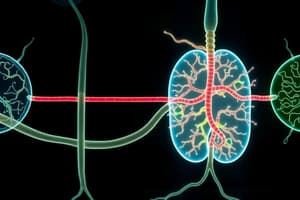Podcast
Questions and Answers
What is the first stage of cellular respiration?
What is the first stage of cellular respiration?
- Energy is directly released for immediate use.
- Oxygen is used to break down smaller molecules.
- Glucose is broken down into smaller molecules in the cytoplasm. (correct)
- Carbon dioxide is produced in large amounts.
Which of the following correctly describes a key difference between cellular respiration and photosynthesis?
Which of the following correctly describes a key difference between cellular respiration and photosynthesis?
- Cellular respiration releases oxygen, while photosynthesis consumes it.
- Photosynthesis is an aerobic process, whereas cellular respiration is not.
- Both processes produce glucose.
- Cellular respiration occurs in the mitochondria, while photosynthesis occurs in chloroplasts. (correct)
What is an outcome of anaerobic respiration?
What is an outcome of anaerobic respiration?
- Production of high amounts of ATP.
- Release of large volumes of oxygen.
- Complete breakdown of glucose into carbon dioxide and water.
- Production of lactic acid in muscle cells. (correct)
During the second stage of cellular respiration, where does the breakdown of smaller molecules occur?
During the second stage of cellular respiration, where does the breakdown of smaller molecules occur?
What byproduct is released during cellular respiration?
What byproduct is released during cellular respiration?
Flashcards
Cellular Respiration
Cellular Respiration
The process where cells break down glucose in the presence of oxygen to release energy.
Alcohol Fermentation
Alcohol Fermentation
The process where energy is released from glucose without using oxygen. This occurs in yeast and other single-celled organisms.
Lactic Acid Fermentation
Lactic Acid Fermentation
The process where glucose is broken down without oxygen in bacteria or muscle cells, producing lactic acid as a byproduct.
ATP (Adenosine Triphosphate)
ATP (Adenosine Triphosphate)
Signup and view all the flashcards
Photosynthesis
Photosynthesis
Signup and view all the flashcards
Study Notes
Cellular Respiration
- Cells obtain energy from glucose through cellular respiration.
- It's a continuous process in all living cells.
- Cells break down glucose and other food molecules with oxygen, releasing energy.
- Two-stage process:
- Stage 1: Glucose breaks down into smaller molecules in the cytoplasm, releasing a small amount of energy. This energy is used to create ATP (adenosine triphosphate) from ADP (adenosine diphosphate).
- Stage 2: Smaller molecules are further broken down in mitochondria, requiring oxygen. Significant energy is released, along with carbon dioxide, to fuel cellular processes.
- Cellular respiration and photosynthesis are opposite processes. Respiration breaks down glucose with oxygen to produce ATP, while photosynthesis uses sunlight to create glucose from carbon dioxide and water.
- Respiration happens in mitochondria, photosynthesis occurs in chloroplasts of plant cells.
Fermentation
- Fermentation is a process to release energy from food without oxygen.
- Less energy is produced compared to respiration.
- Types of fermentation:
- Alcohol fermentation: Occurs in yeast and some single-celled organisms. Produces alcohol, carbon dioxide, and a small amount of energy.
- Lactic acid fermentation: Happens in bacteria and muscle cells. Breaks down glucose into energy without oxygen, generating lactic acid as a byproduct.
Studying That Suits You
Use AI to generate personalized quizzes and flashcards to suit your learning preferences.
Description
Explore the processes of cellular respiration and fermentation in this quiz. Learn how cells obtain energy from glucose, the stages of respiration, and the differences between respiration and photosynthesis. Test your understanding of these essential biological processes.




